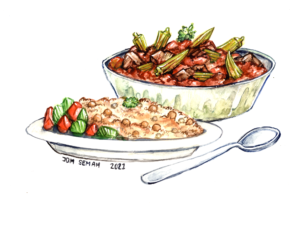Bloed, zweet en tranen of: Churchill, Cash en Hazes
Eén keer trek je de conclusie
Vriendschap is een illusie
Vriendschap is een droom
Een pakketje schroot met een dun laagje chroom
’t Is moeilijk bescheiden te blijven
Wanneer je zo goed bent als ik
Zo stoer, zo charmant en zo aardig
Dat zie je in één ogenblik
En ik ben blij dat ik je niet vergeten ben
Dat ik nog zo veel kleine dingen van je ken
Omdat ik steeds ben blijven dromen
dat het toch zo ver zou komen
Ben ik blij dat ik je niet vergeten ben
Met bloed, zweet en tranen
Zei ik, rot hier nu maar op
Met bloed, zweet en tranen
Zei ik vrienden, dag vrienden, de koek is op
Wat is er bevrijdender – althans, vanuit therapeutisch oogpunt bezien – dan voluit meeblèren met een vol Ahoy of Goffert? Of een bomvolle Johan Cruyff Arena, sinds de Ajax-aanhang zich de André Hazes-hit Bloed, zweet en tranen heeft toegeëigend?
Dat begrip – bloed, zweet en tranen – wordt buiten onze landsgrenzen – en wellicht ook daarbinnen – waarschijnlijk op de eerste plaats geassocieerd met Blood, Sweat & Tears of, zoals het vaker werd weergegeven, BS&T, de New Yorkse jazzrockband die tussen maart 1969 en oktober 1970 megahits had met You’ve made me so very happy, Spinning wheel, And when I die en Hi-De-Ho.
De oorsprong voor de naam van de band wordt gewoonlijk toegeschreven aan de speech die Winston Churchill hield in het Lagerhuis op 13 mei 1940, bij het begin van zijn eerste periode als minister-president.
Voluit klinkt de passage als volgt: “I would say to the House, as I said to those who have joined this Government: I have nothing to offer but blood, toil, tears and sweat.”
Churchill mag dan wel in 1953 de Nobelprijs voor literatuur gewonnen hebben – een belangrijk deel van zijn werkzame leven verdiende hij meer met schrijven en als veelgevraagd spreker dan als politicus – , voor de woorden die hij wereldberoemd zou maken, moest hij toch putten uit de Engelse letteren.
De poëet en avonturier Lord Byron (1788-1824) schreef in zijn meer dan 100 pagina’s tellende gedicht The Age of Bronze, dat in 1823 verscheen
Year after year they voted cent per cent,
Blood, sweat, and tear-wrung millions – why? for rent!
En nog verder terug in de Britse literatuurgeschiedenis vindt men de dominee-dichter John Donne (1572-1631), die in zijn gedicht An Anatomy of the World (1611) schrijft:
That ’tis in vain to dew, or mollifie it with thy tears, or sweat, or blood
(to dew = bevochtigen, to mollify = verzachten).
De enumeratie ‘bloed, zweet en tranen’ moet, in welke volgorde dan ook, dus al heel lang niet alleen bestaan hebben, maar ook als literaire eenheid gebruikt zijn.
Het is intussen maar zeer de vraag of die beroemde woorden van Churchill BS&T geïnspireerd hebben bij de keuze van een naam. Om te beginnen worden ze niet exact geciteerd. Sterker nog, uit de oorspronkelijke tekst is een vierde woord – toil, gezwoeg – weggelaten en staan sweat en tears in de omgekeerde volgorde.
Ten tweede heeft Al Kooper, een van de oprichters van BS&T, zich uitgelaten over de herkomst van hun naam. In zijn autobiografie met de weinig van aangename herinneringen getuigende titel Backstage Passes and Backstabbing Bastards (1998), herinnert hij zich: ‘One particular night, Jimi Hendrix, B. B. King, myself, and an unidentified drummer and bass player were going at it all night at the Cafe Au Go Go. At daybreak, when we finished playing, they put the house lights on and somebody observed: ‘Christ! Look at the organ! There’s blood all over the keyboard!’ Sure enough, I had cut my hand playing, and in the state of bliss induced by my compatriot’s sound had not felt a thing. What a great album cover, I thought. No. What a great name for a band.’
Geen uitleg die meteen overtuigt, al was het maar omdat al dat bloed wel verklaard wordt maar de herkomst van de tranen en het zweet onbekend blijft. Dan geloven wij eerder, dat de naam van de band geïnspireerd is door de country-zanger Johnny Cash, die immers in 1963 een album uitbracht met de titel Blood, sweat and tears. (Dat laat natuurlijk de vraag onverlet waar Cash het vandaan heeft.)
Blood, toil, tears and sweat is trouwens niet het enige spoor dat Churchill in de popmuziek heeft achtergelaten. Om overigens volstrekt onduidelijke redenen koos een Amerikaanse band als naam The Beginning of the End. Hun enig bekende wapenfeit is het album Funky Nassau (1971), interessanter is de bron van hun naam.
Uit weer een andere toespraak van Churchill, in november 1942, ging dit citaat een eigen leven leiden: “This is not the end. It is not even the beginning of the end. But it is, perhaps, the end of the beginning.”
Het was een verwijzing naar de aanval van Field Marshal Bernard Montgomery – koosnaam Monty – op de Duitse troepen onder aanvoering van generaal-veldmaarschalk Erwin Rommel – bijnaam de Woestijnvos – in Noord-Afrika.
Het was al met al dan ook niet te vermijden, dat blood, sweat and tears enkele minder creatieve geesten zou verleiden tot speels bedoelde titels van hun memoires. Zo herleefde Steve Katz, mede-oprichter van BS&T, zijn wildste jaren in het boek Blood, sweat, and My Rock ‘n’ Roll years (2015).
Nog makkelijker maakten de drie makers van een boek over Rocker33, een van de spraakmakendste nachtclubs in Duitsland, zich van de titel af. Zij kwamen eendrachtelijk op Love, sweat and tears (2020).
Succes verzekerd!
Is Neoliberalism Dying? A Structuralist Approach To Predatory Global Capitalism And The Challenge of Reform*

C.J. Polychroniou
Forty years of neoliberal rule have produced devastating effects on lower and working-class people and on the social fabric throughout the world: wages have stagnated, labor rights have been trampled, and economic inequalities have exploded. Neoliberalism has also proven detrimental to democracy as many forms of collective decision-making and even faith and trust in the ability of government to solve problems have been severely eroded by the marketization project. Citizens have been encouraged to think and act like consumers and powerful private interests have made a mockery of the idea of a common good. Moreover, trends of ongoing income and wealth inequality combined with job insecurity and the hijacking of the state by the economic elites has led to the eruption of popular anger, leading to the rise of a new generation of authoritarian rulers and to a concomitant attack on the traditional democratic order, along with an explosion of xenophobic rage and racism.
Nonetheless, neoliberalism has remained the hegemonic paradigm in the workings of contemporary capitalism and the operating framework of the global economy, even though this particular form of economic governance is prone to systemic crises and in spite of challenges and sporadic forms of resistance from below.
At least until now, that is. For the eruption of the pandemic appears to have discredited market fundamentalism and state interventionism has returned with vengeance throughout the West. We have seen massive monetary and fiscal packages introduced both in Europe and the United States in order to provide relief for unemployed workers and struggling businesses in ways that have not been seen in many decades. During the global financial crisis of 2008, the state bailed out the financial sector and turned a blind eye towards homeowners and the millions of people suffering from the consequences of “predatory capitalism” that neoliberalism gave rise to from the mid-1970s and continued to fuel throughout the next four decades. However, during the era of the pandemic, the state has come to some degree to the rescue of the entire economy, although still not as aggressively as economic thinking associated with the name and work of John Maynard Keynes would surely recommend for a crisis as severe as the one thrusted upon the world by the eruption of the Covid pandemic, which has created a classic capitalist crisis of accumulation.
Be that as it may, the question popping up suddenly (once again, we might add, since the same question popped up after the financial crisis of 2008) is whether the return of “Big Government” during the pandemic is signaling the end of neoliberalism.
My view on this matter is that it is too early to tell, and, more importantly, that neoliberalism is not going to wither away without an increased role of participatory democracy and the emergence of political vehicles (political parties and social movements) envisioning and fighting for an alternative social order. Neoliberalism is not merely an ideology or even a specific policy at this point, but an institutional component, a substructure, of the very capitalist system that has been built in the age of globalization, and thus the measures taken today to address the economic effects of the pandemic may be quite temporary and the world could easily return to “business as usual” once the pandemic has been brought under control.
Let me elaborate
Any effort to fully understand the nature of contemporary capitalism should begin with the recognition that the whole is indeed greater than the sum of its parts. It is also pertinent that we recognize the importance of structural causality in making sense of contemporary capitalist developments while avoiding methodological reductionism. As such, we need to look at the overall structure of the system; that is, we need to comprehend the different constitutive parts of the system that keep it together and running in ways which are harmful to the interests of the great majority of the population, dangerous to democracy and public values, and detrimental to the environment and earth’s ecosystem. Focusing on one element of the system while ignoring other things (perhaps because we think that they constitute incidental outcomes or processes of secondary nature) may limit our understanding by creating a flawed perspective about the dynamics and the contradictions of contemporary capitalism and thereby undermine our ability to propose sound and realistic solutions.
Now, we know what capitalism is, and how it basically works. It is a specific, historically determined mode of production, a ruthless economic system representing the most advanced form of commodity production. It is not an economic system designed to serve the needs of society as such, because the extraction of profit is the “logic” that drives capitalist commodity production. Not only that, but when left to operate without regulations, capitalism can wreak havoc on societies. Exploitation and inequality represent structural necessities of the system itself, and capital itself is nothing other than value that generates surplus value.
Moreover, capital accumulation is an anarchic and contradictory process, and with a constant need to expand, all of which result all too frequently in systemic crises that threaten to destroy capitalism itself and which, subsequently, mandate the intervention of the state in order to save the system from collapse. In the age of the financialization of capital, systemic crises have become far more frequent, and with greater severity, and government bailouts have emerged as the essential tool through which the system avoids a catastrophic collapse.
Capitalist expansion has taken place over the course of the past five centuries via different venues, ranging from plunder and exploitation, through trade, to investment in industry and the financialization of assets. However, the state has been the driving agency behind the spread and consolidation of capitalism from the very start. And it is no less the case than with the architecture of contemporary capitalism.
The landscape of contemporary capitalism has been structured around three interrelated elements: financialization, neoliberalism and globalization. All three of these components constitute part of a coherent whole which has given rise to an entity that can be briefly described as “predatory global capitalism.”
As such, contemporary capitalism is characterized by a political economy which revolves around finance capital, is based on a savage form of free market fundamentalism and thrives on a wave of globalizing processes and global financial networks that have produced global economic oligarchies with the capacity to influence the shaping of policymaking across nations. Indeed, today’s brand of capitalism is particularly anti-democratic and simply incapable of functioning in a way conducive to maintaining sustainable and balanced growth. By waging vicious class warfare, the economic elite and their allies have managed in the contemporary era to roll back progress on the economic and social fronts by resurrecting the predatory, “free-market” capitalism that immiserated millions in the early 20th century while a handful of obscenely wealthy individuals controlled the bulk of the wealth.
The capitalist order we have in place today has its roots in the structural changes that took place in the accumulation process back in the mid-to-late 1970s. The 1970s was a decade of economic slowdown and inflationary pressures in the advanced capitalist world. The crisis, brought about by new technological innovations, declining rates of profit and the dissolution of the social structures of accumulation that had emerged after World War II, led to sluggish growth rates, high inflation and even higher rates of unemployment, bringing about a phenomenon that came to be known as “stagflation.”
From a policy point of view, “stagflation” signaled the end of an era in which there was a trade-off between inflation and unemployment (shown by the Phillips curve) and, by extension, the end of the dominance of the Keynesian school of thought.
The Art Of Cooking – Bamia With Rice
 Bamia (Okra Stew) is an important dish in Iraqi cuisine, it is a simple dish and yet a delicious dish that can be made with or without meat.
Bamia (Okra Stew) is an important dish in Iraqi cuisine, it is a simple dish and yet a delicious dish that can be made with or without meat.
Bamia (Okra) itself is not the most popular vegetable out there, but once you can look past its slimy structure it is actually really tasty.
Bamia has a rich sweet and earthy flavor which is well contrasted with the acidity of tomato.
Bamia as well as other stew are great to eat with rice – in this recipe, I will teach you how to make your rice a little bit more exciting!
Ingredients:
Okra 500 gram (you can find Okra at your local Mediterranean shop, It should be fine for both fresh or frozen)
Lamb meat 500 gram (it could be made with either meat or chicken)
Can of peeled tomatoes
Tomato paste
2 onions
Garlic
White rice (I myself prefer Basmati rice, but any white rice will do)
Can of chickpeas
Salt & Pepper
Dried bay Leaf
Cumin
Cooking oil
Bamia (Okra Stew):
Start with heating up a layer of oil in a big pot.
Season the meat with salt and pepper and add it to the hot oil.
Make sure all sides of the meat get cooked do not worry about the pot getting too sticky.
Next add some cumin, diced garlic, and diced onion.
When the onion turns translucent, add some tomato paste together with the can of peeled tomatoes.
Use the liquid to clean the bottom of the pan and mix the flavor into the sauce.
Rinse the okra and add it to the pan, add enough water to cover all ingredients, and let it simmer for an hour or more (the more the better).
Make sure it does not get too dry while simmering on the stove.
When the meat is soft enough (prick the meat with a fork to check if it is ready).
Taste for salt before serving.
Rice:
Let’s try to make exciting rice, for the extra pleasure of eating the Bamia.
First of all, measure the rice into a cup and level the top, and then rinse it in cold water – make sure to remove all the dirt – prepare a measured amount of water equal to 1 and a half cup that you used for the rice.
In a deep frying pan add a layer of cooking oil, when the oil is hot add a dried bay leaf and chopped onions, and some cumin.
When the onion turns translucent, add some tomato paste and be sure to stir frequently.
As the mixture starts to dry up add the water you have already measured and mixed all together.
After mixing the water with the paste add the rice and chickpeas (make sure to rinse the chickpeas in cold water) and add a pinch of salt.
Now put the lid on the frying pan, and make sure the water simmers – once the water starts boiling turn the heat down.
When the water is no longer visible in the pot, the rice is ready.
It is nice to serve the Bamia and the rice, with some fresh cucumber, tomato, and with some chopped parsley leaves on top.
Please try to make Bamia, even if you never had Okra before – it is after all a unique vegetable.
So finally, I hope you like it as much as I do.
Chomsky: Biden’s Early Agenda Gives Hope, But Activist Pressure Must Not Cease
Joe Biden’s first months in office have comprised a flurry of actions on the domestic front, including a historic stimulus bill. In this exclusive interview, the celebrated public intellectual Noam Chomsky shares his views on some key policies embraced by the Biden administration. Chomsky is Institute Professor Emeritus at MIT and Laureate Professor of Linguistics at the University of Arizona. His latest books are Climate Crisis and the Global Green New Deal: The Political Economy of Saving the Planet (co-authored with Robert Pollin and C. J. Polychroniou; Verso, 2020), Chomsky for Activists (Routledge, 2020) and Consequences of Capitalism: Manufacturing Discontent and Resistance(Haymarket Books, 2020).
C.J. Polychroniou: President Joe Biden has been in office for approximately two months now, in the course of which he has signed scores of executive orders meant to reverse the policies of Donald Trump. But he has also managed to pass a huge and ambitious stimulus bill unlike anything seen during peacetime. What’s your assessment of Biden’s actions so far to deal with the most pressing issues facing U.S. society: namely, the coronavirus pandemic and the pain caused to millions of Americans on account of the pandemic?
Noam Chomsky: Better than I’d anticipated. Considerably so.
The stimulus bill has its flaws, but considering the circumstances, it’s an impressive achievement. The circumstances are a highly disciplined opposition party dedicated to the principle announced years ago by its maximal leader, Mitch McConnell: If we are not in power, we must render the country ungovernable and block government legislative efforts, however beneficial they might be. Then the consequences can be blamed on the party in power, and we can take over. It worked well for Republicans in 2009 — with plenty of help from Obama. By 2010, the Democrats lost Congress, and the way was cleared to the 2016 debacle.
There’s every reason to suppose that the strategy will be renewed — this time under more complex circumstances. The voting base in the hands of Trump, who shares the objective but differs from McConnell on who will pick up the pieces: McConnell and the donor class, or Trump and the voting base he mobilized, almost half of whom worship him as the messenger God sent to save the country from … we can fill in our favorite fantasies, but should not overlook the fact that what may sound [ridiculous] has roots in the lives of the victims of the neoliberal globalization of the past 40 years — extended by Trump, apart from some rhetorical flourishes.
In those circumstances, passing a stimulus bill was a major accomplishment. Republicans who favor it, and know that their constituents do, nevertheless voted against it, in lockstep obedience to what the Central Committee determines. Some Democrats insisted on watering it down. But what finally passed has valuable elements, which could be a basis for moving on.
There are huge gaps. The bill surely should have contained an increase in the miserable minimum wage, an utter scandal. But that would have been very difficult in the face of total Republican opposition, along with a few Democrats. And there are other crucial features that are missing. Nevertheless, if the short-term measures on child poverty, income support, medical insurance and other basic needs can be extended, it would be a substantial step toward fulfilling the promise envisioned by such careful observers as Roosevelt Institute President Felicia Wong, who reflected that, “As I see it, both the scale and the direction of the American Rescue Plan break the neoliberal, deficits-and-inflation-come-first mold that has hollowed out our economy for a generation.” We haven’t seen anything that could elicit such hopes for a long time.
There is also hope in appointments on economic issues. Who would have imagined that a regular contributor to radical economics journals would be appointed to the Council of Economic Advisers (Heather Boushey), joined by the senior economic adviser of the labor-oriented Economic Policy Institute, (Jared Bernstein)?
Biden’s strong support for Amazon workers, and unions generally, is a welcome shift. Nothing like it has been heard from the chambers of power in many years. In a sharp reversal of Trump legislation, the tax changes raise incomes mostly for the poor, not the rich. Economic Policy Institute President Thea Lee summarizes the package by saying that it “will provide crucial support to millions of working families; dramatically reduce the race, gender, and income inequalities that were exacerbated by the crisis; and create the conditions for a truly robust recovery once the virus is under control and people are able to resume normal economic activity.” Optimistic, but within reach.
House Democrats have passed other important legislation. H.R. 1 protects voting rights, a critical matter now, with Republicans working overtime to try to block the votes of [people of color] and the poor, recognizing that this is the only way a minority party dedicated to wealth and corporate power can remain viable.
On the labor front, the House passed the Protecting the Right to Organize (PRO) Act, “a critical step toward restoring workers’ right to organize and bargain collectively,” the Economic Policy Institute reports, a fundamental right that “has been eroded for decades as employers exploited weaknesses in the current law.” It’ll probably be killed by the Senate. Even apart from party loyalty, there is little sympathy for working people in Republican ranks.
But even so, it’s a basis for organizing and education. It can be a step toward revitalizing the labor movement, a prime target of the neoliberal project since Reagan and Thatcher, who understood well that working people must be deprived of means to defend themselves from the assault.
Decline of union membership is by now recognized, even in the mainstream, to be a major factor in rising inequality — a phrase that translates to “robbery of the general public by a tiny fraction of super-rich.” The Economic Policy Institute has reviewed the facts regularly, most recently in a chart that graphically demonstrates the remarkable correlation between rising/falling union membership and falling/rising inequality.
More generally, there is a good opportunity to overcome the baleful legacy of Trump’s bitterly anti-labor Labor Department, headed by corporate lawyer Eugene Scalia, who used his term in office to eviscerate worker rights, notoriously during the pandemic. Scalia was perfectly chosen for the transformation of the Republicans to a “working-class party,” as hailed by Marco Rubio and Josh Hawley in a triumph of propaganda, or maybe sheer chutzpah.
Michael Regan’s appointment as Environmental Protection Agency administrator should replace corporate greed by science and human welfare in this essential agency, a move toward human decency that in this case is a prerequisite for survival.
It’s easy to find serious omissions and deficiencies in Biden’s programs on the domestic front, but there are signs of hope for emerging from the Trump nightmare and moving on to what really should, what really must be done. The hopes are, however, conditional. The temporary measures of the stimulus on child poverty and many other issues must be made permanent, and improved. Crucially, activist pressure must not cease. The masters of the universe pursue their class war relentlessly, and can only be countered by an aroused public opposition that is no less dedicated to the common good.
What do you think of Biden’s refusal to cancel $50,000 in student loans?
A bad decision. What the realistic options were, I don’t frankly know. Higher education at a high level should be recognized to be a basic right, freely available, as it is elsewhere: in our Mexican neighbor, in rich developed countries like Germany, France, the Nordic countries, and a great many others, with at most nominal fees. As it substantially was in the U.S. when it was a much poorer country than it is today. The postwar GI Bill of Rights provided free education for great numbers of white males who would never have gone to college otherwise. There is no reason why young people of any race should be denied the privilege today.
In light of the January 6 attack on the U.S. Capitol, Biden has vowed to fight domestic terrorism by passing a new law “that respects free speech and civil liberties.” Does the U.S. need a new domestic terrorism agenda?
A prior question is whether we should retain the current domestic terrorism agenda. There are strong reasons to question that. And any expansion should be a matter of serious concern. That aside, white supremacist violence is no laughing matter. Through the Trump years, the FBI and other monitors report steadily increasing white supremacist terror, by now covering almost all recorded terror. Armed militias are rampant — Trump’s “tough guys” as he’s admiringly called them. The problems can’t be overlooked, but have to be handled with great caution and a close eye on the temptations for abuse.
Biden has proposed a plan to strengthen the middle class by encouraging unionization and collective bargaining, and his recent affirmation of the rights of workers to unionize, which was widely interpreted as support for Amazon workers’ rights to organize in Alabama, has spread considerable enthusiasm among progressives. Indeed, Biden’s support for unions is in pace with the highly favorable ratings that unions have been receiving in the last couple of years. What’s behind the support for unions in the present era?
One reason is objective reality. The sharp rise in inequality is a growing curse, with extremely harmful effects across the society. As mentioned earlier, it closely tracks decline of unions, for reasons that are well understood. Historically, labor unions have been in the forefront of struggles for justice and rights. They also pioneered the environmental movement, as we’ve discussed before. Workers’ organizations are changing in character with the growth of service and knowledge-based economies. They have shared interests, and foster the values of solidarity and mutual aid on which the hope for a decent future rest. Many unions retain the world “international” in their names. It should not just be a symbol or a dream. The dire challenges we face have no borders. Global heating, pandemics, disarmament will be dealt with internationally, if at all. The same is true of labor rights and human rights more generally. At every level, associations of working people should once again be prominent, if not leading the way, toward a better world.
This interview has been lightly edited for clarity.
Copyright: https://truthout.org/
C.J. Polychroniou is a political economist/political scientist who has taught and worked in universities and research centers in Europe and the United States. His main research interests are in European economic integration, globalization, the political economy of the United States and the deconstruction of neoliberalism’s politico-economic project. He is a regular contributor to Truthout as well as a member of Truthout’s Public Intellectual Project. He has published several books and his articles have appeared in a variety of journals, magazines, newspapers and popular news websites. Many of his publications have been translated into several foreign languages, including Croatian, French, Greek, Italian, Portuguese, Spanish and Turkish. He is the author of Optimism Over Despair: Noam Chomsky On Capitalism, Empire, and Social Change, an anthology of interviews with Chomsky originally published at Truthoutand collected by Haymarket Books.
Erin Ben-Moche – Photographer Zion Ozeri Showcases Jewish Diversity in Virtual Haggadah & Pictures Tell: A Passover Haggadah
 Renowned Jewish photographer Zion Ozeri is no stranger to creating meaningful Haggadot. His award-winning photographs, which capture the world around him, have appeared in The New York Times, Newsweek, The Jerusalem Report, Moment and The Economist, to name a few publications.
Renowned Jewish photographer Zion Ozeri is no stranger to creating meaningful Haggadot. His award-winning photographs, which capture the world around him, have appeared in The New York Times, Newsweek, The Jerusalem Report, Moment and The Economist, to name a few publications.
After reviewing his pieces, Ozeri decided to create a virtual interactive Haggadah that highlights the diversity of Jews, just in time for a second pandemic Passover.
Ozeri, along with Sara Wolkenfeld and Josh Feinberg, curated “Pictures Tell: A Passover Haggadah,” a Haggadah that is completely virtual (can be utilized at home or in a classroom) and celebrates the traditions and cultural experiences of the Jewish Diaspora. Ozeri told the Journal that a major goal of “Pictures Tell” is using imagery to tell the story of the Jewish people.
Source: https://jewishjournal.com/photographer-zion-ozeri-showcases-jewish-diversity-in-virtual-haggadah/
Instructions To Tinbergen Authors
Instructions To Tinbergen Authors
Some technical terms
Typescript – Entire book excluding the cover
Prelims – Beginning of the book, all pages before the main text begins (title page, contents, foreword, etc.)
Half title – Page I: title only in caps
Dissertation page – Page III – text according to the University standard
Professors’ page – Page IV – names of the professors
ISBN – International Standard Book Number, assigned by the publisher
NUR – (Dutch standard subject classification) classification according to subject
Contents/sequence
• Prelims generally have no page numbering. If numbering is necessary use roman numerals. Pagenumbering begins at the start of the main text.
• Each new section begins on a right-hand page. If necessary, insert a blank left-hand page. Include this number in the page-count, but do not number.
• Sequence: foreword, introduction, chapter 1, 2, 3, etc., appendix(es), recapitulation, bibliography, index, thanks (if applicable), curriculum vitae.
• On page II come the words ‘This book is number…..in the…..series’ etc. and the designer’s name + ISBN
Layout
Keep the layout simple, logical and consequential. The author is responsible for delivery of the entire manuscript, which should be of sufficient quality that the printer can begin work without further adjustment. The quality shall be judged by Rozenberg Publishers. The last pages must contain the list of all titles published in the Series. An updated list may be obtained from the Tinbergen Institute in Rotterdam.
Type area: 16 x 23 cm. (Excluding the page number, headers)
In Microsoft Word the page margins would be:
Top: 2 cm – 3,5 cm
Bottom: 2,5 cm
Left: 3 cm
Right: 2,5 cm
Header: 1,25 cm – 2,5 cm
Footer: 1,25 cm
Type face: Preferable Times
Type size: Main text: 12-point. This becomes 10-point after 80% reduction. Notes: 10-point. After reduction this becomes 8-point.
Compare the results in advance by reducing (80%) a sample page on a photocopier.
Headings: Logical and consequential. Create a hierarchy.
Bold type: Avoid underlining. Use bold type and italics in moderation.
Pagination: Preferably alternating left and right at the bottom of the page.
If pages must be numbered at the top, it should be done consistently. Do not put a number at the foot of page in a new chapter; simply omit it. Pages with no text, should not be numbered – they should – of course, be counted.
Tables etc. Black lines and dots are part of the text and will therefore also be reduced to 80%.
Handing in your completed and designed manuscript to Rozenberg Publishers:
PDF
Very important when working with PDF files is using the right software. A lot of the free available software is only useful for creating PDFs for screen use, and not for print. Our preference goes to Adobe Distiller.
If you hand in a trial chapter at an early stage, for us to check, it may avoid surprises in a later stage.
Please be aware that we can hardly make any corrections in your PDF files. If there are any mistakes/errors in your proof, you will have to hand in new PDF files.
Jacket
Rozenberg Publishers will ensure that the text fits in the style of the Tinbergen dissertation series. This is a fixed style of typesetting and cannot be altered.
The author must provide by e-mail (textfile ) with title, subtitle, names of authors, university from which the author is graduating and the number in the series. In addition there should be a short summary of the content and (if you like) author biography (in total max. 200 words). The text should give a clear idea of what the book is about – not a summary. Before the final printing of the jacket a proof (PDF) will be made for the author’s approval.
Illustration
The resolution of the illustration for the cover should be at least 300 dpi. We would like to receive the illustration as jpeg- or tiff-file.
Please note: either you own the copyright of the illustration or it is copyright-free. You can find a lot of copyrightfree illustrations in databases like Wiki Commons, freepik.com, etc.
Of course you can also choose a cover without illustration.
Invitation cards and ‘Stellingen’ are not part of the arrangement between Rozenberg Publishers and the Tinbergen Institute.
Planning and production
A period of 4 weeks is needed for the printing and binding of the book. If you would like to receive a (paper) proof, we need one week extra.
If possible it is advisable to deliver it sooner. The key to the planning is the date on which the book must be at the pedel, it is then possible to count backwards to the last possible date.
The author sends the manuscript by e-mail to:
Drukkerij Haveka bv
van Hennaertweg 23
2952 CA Alblasserdam
tel.: (+) 31 (0)78–691 23 23
t.hartog@haveka.nl
Tonny Hartog
Or to:
Rozenberg Publishers – Auke van der Berg
Amsterdam
aukevdberg@gmail.com




